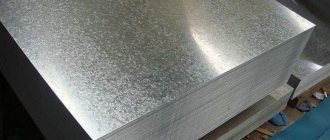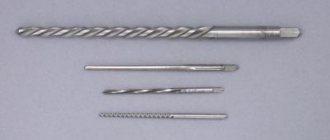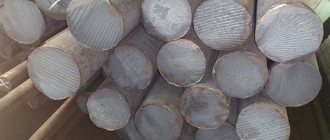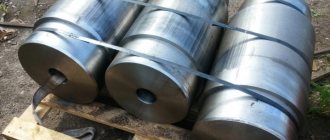The mechanical properties of steel made with alloying additives meet the stringent requirements for industrial use. To obtain steel with certain properties, silicon, manganese, chromium, titanium, molybdenum, tungsten, nickel and other chemical elements are introduced during the smelting process. One of the special steel grades produced is 60C2A, which has high strength and pronounced springing properties. The main feature of this steel is its increased yield strength. This feature makes it possible to produce various products with spring properties.
Chemical composition
In addition to iron, grade 60C2A steel contains about 0.6% carbon, 1.6 to 2% silicon, 0.6 to 0.9% manganese, up to 0.3% chromium, up to 0.25% nickel and up to 0. 2% copper. In addition, impurities of sulfur and phosphorus are allowed in amounts up to 0.025%.
Purpose of alloying components
Steel is an alloy of iron and carbon in an amount of up to 2.06%. Increasing the amount of carbon increases sensitivity to heat treatment, hardenability, and the ability to obtain greater strength and hardness. But at the same time, ductility decreases, the metal becomes brittle, unable to withstand shock loads.
In order to balance the properties of the material, simultaneously obtain opposite characteristics (hardness and toughness, strength and corrosion resistance), and reduce the influence of impurities that cannot be completely eliminated, 60C2A steel includes alloying components. They make it possible to neutralize the disadvantages introduced by a high amount of carbon. And in some ways replace it, getting even better results.
Silicon is introduced into the composition for the purpose of deoxidation. Possessing a greater affinity for oxygen than iron, it displaces it from oxides in the melt.
In addition to deoxidation in amounts up to 1%, silicon has a beneficial effect on strength and elasticity.
Manganese, like silicon, displaces iron from oxides. In addition, it prevents the formation of iron sulfides, which increase the tendency to form hardening cracks that occur during thermal hardening of parts with complex shapes.
The inclusion of manganese in the alloy up to 1%, like silicon, increases strength and toughness. In large quantities, it causes grain growth, which reduces strength indicators, in particular the ability to withstand shock loads.
Thus, silicon and manganese mutually complement each other in composition. They work together to increase strength, endurance and toughness. But the reasons leading to increased fragility of the alloy are not allowed to develop.
Chromium, like silicon and manganese, has a greater affinity for oxygen than iron. It helps protect the melt from oxidation and increases hardenability.
Nickel helps protect the alloy from corrosion and, in small quantities, reduces the susceptibility to hardening cracks.
Copper in small (up to 1%) quantities increases strength and resistance to corrosion. At higher concentrations, it leads to the precipitation of intermetallic compounds along grain boundaries, which significantly changes the mechanical properties during tempering.
Comparing the chemical composition and the influence of individual components on the properties of the alloy, it can be assumed that the 60C2A grade should have high strength, elasticity, and impact strength, achieved by observing special heat treatment techniques.
steel 60S2A
Home->Directory->Steel grade->Structural steel
steel 60С2Н2А Steel 45ХН
Brand 60С2А – purpose
Structural spring steel 60C2A is used for the manufacture of heavily loaded springs, spring rings, torsion shafts, collets, spring washers, friction discs, and other products operating at temperatures up to 2500C.
Additional information. When the material is heated, grain growth does not occur. Steel 60S2A is highly prone to decarburization; after heat treatment it has high strength/elasticity, good resistance to alternating/shock loads; after isothermal hardening, the material acquires the best properties.
Steel 60S2A - domestic analogues
| Rolled metal grade | Substitute |
| 60С2 | 50HFA |
| 60S2G | |
| 60С2Н2А |
Material 60С2А – characteristics
| Brand | Classification | Type of delivery | GOST | Foreign analogues |
| 60С2 | Structural spring steel | Long products | 14959–79 | There is |
| Ribbon | 2283–79 | |||
| 2284–79 | ||||
| 21996–76 | ||||
| 21997–76 | ||||
| Wire | 14963–78 |
Brand 60С2А – technological features
Heat treatment
| Mode | Cooling medium | t, 0С |
| Hardening | oil | 870 |
| Vacation | 420 |
Forging
| Type of semi-finished product | t, 0С | Cooling | |
| Section size | Conditions | ||
| mm | |||
| Ingot | 1200–800 | up to 300 | Low temperature annealing |
| Hypothermia | |||
| Blank | up to 250 | On air | |
| 251–300 | In the hole | ||
Welding
| Weldability |
| not applicable for welded structures |
Flock sensitivity
Not sensitive.
cutting
| Initial data | Machinability Κυ | |||
| State | HB, MPa | σΒ, MPa | hard alloy | high speed steel |
| hot rolled | 270–320 | 1100 | 0,70 | 0,27 |
Tendency to temper brittleness
Not inclined.
Steel 60S2A - chemical composition
Mass fraction of elements no more than, %:
| Silicon | Manganese | Copper | Nickel | Sulfur | Carbon | Phosphorus | Chromium |
| 1,6–2 | 0,6–0,9 | 0,2 | 0,25 | 0,025 | 0,58–0,63 | 0,025 | 0,3 |
Material 60С2А – mechanical properties
| Assortment | GOST | Dimensions – thickness, diameter | Heat treatment mode | t | KCU | ψ | δ5 | σT | σв |
| mm | 0C | kJ/m2 | % | % | MPa | MPa | |||
| Rental | 14959–79 | Quenching (oil) | 870 | 20 | 6 | 1375 | 1570 | ||
| Vacation | 470 | ||||||||
| The tape is annealed. | 2283–79 | 0,1–4 | 8 | 880 | |||||
| hardened. | 780–1180 |
Hardness, MPa
| Assortment | GOST | HB 10-1 |
| Rolled after annealing | 14959–79 | 269 |
| without heat treatment | 302 |
Temperature of critical points, 0С
| Critical points | Ac1 | Ac3 | Ar1 | Ar3 | Mn |
| Temperature | 770 | 820 | 700 | 770 | 305 |
Impact strength, J/cm2
| Heat treatment modes | Wednesday | t | KCU at temperatures | ||||||
| 0C | -700С | -600С | -400С | -300С | -200С | 00С | +200С | ||
| Hardening | oil | 860 | 34 | 39 | |||||
| Vacation | air | 425 | |||||||
Endurance limit, Pa
| State | τ−1 | σ−1 | ||
| σв | Heat treatment | t | ||
| MPa | 0C | MPa | MPa | |
| 1380 | Quenching (oil) | 860 | 637 | |
| Vacation | 550 | |||
Grade 60С2А – physical properties
| t | ρ | R 109 | E 10-5 | λ | α 106 | C |
| 0C | kg/m3 | Ohm m | MPa | W/(m deg) | 1/Grad | J/ (kg deg) |
| 20 | 7680 | 2.12 | 28 | |||
| 100 | 7660 | 2.06 | 29 | 11.8 | 510 | |
| 200 | 7630 | 1.98 | 29 | 12.7 | 510 | |
| 300 | 7590 | 1.92 | 30 | 13.3 | 520 | |
| 400 | 7570 | 1.81 | 30 | 13.7 | 535 | |
| 500 | 7520 | 1.78 | 30 | 14.1 | 565 | |
| 600 | 1.58 | 29 | 14.5 | 585 | ||
| 700 | 1.44 | 29 | 14.4 | 620 | ||
| 800 | 1.34 | 28 | 12.2 | 700 |
Steel 60S2A - exact and closest foreign analogues
| England | Bulgaria | Germany | China | Poland | USA | France | Japan |
| B.S. | BDS | DIN, WNR | G.B. | PN | — | AFNOR | JIS |
| 251H60 | 60S2A | 60MnSiCr4 60SiCr7 65Si7 | 60Si2Mn | 60S2A | 9260 G92600 | 61SiCr7 | SUP6 SUP7 |
Material 60С2А – area of application
Steel grade 60C2A is used in mechanical engineering for the manufacture of spring-type products operating at temperatures up to 2500C.
Legend
Mechanical properties
| HRСе | HB | KCU | ψ | δ5 | σT | σв |
| MPa | kJ/m2 | % | % | MPa | MPa | |
| Rockwell hardness | Brinell hardness | Impact strength | Relative narrowing | Elongation at break | Yield strength | Short-term strength limit |
| Κυ | σ0.2 | τ−1 | σ−1 |
| Relative machinability factor | Proof of yield strength with 0.2% tolerance when loaded to plastic strain value | Torsional endurance limit (symmetrical cycle) | Endurance limit under compression-tension (symmetrical cycle) |
| N | number of deformation/stress cycles sustained by an object under load before fatigue failure/crack appears |
Weldability
| No limits | Limited | Difficult to weld | |
| Heating | No | up to 100–1200С | 200–3000С |
| Heat treatment | No | There is | annealing |
Physical properties
| R | Ohm m | Resistivity |
| ρ | kg/m3 | Density |
| C | J/(kg deg) | Specific heat |
| λ | W/(m deg) | Coefficient of thermal conductivity |
| α | 1/Grad | Linear expansion coefficient |
| E | MPa | Elastic modulus |
| t | 0C | Temperature |
You can buy structural spring steel 60S2A in St. Petersburg by calling +. Specialists will place your order and advise you on the assortment, prices, and delivery conditions.
Steel 30KhGT Steel 35KhN1M2FA Steel 40 Steel 40G Steel 45KhN Grade A20 Grade A30 Steel 08 Steel 08kp Steel 08ps Steel 08Yu Steel 09G2 Steel 09G2S Steel 10 Steel 10G2 Steel 10G2BD Steel 10G2S1 Steel 10kp S hoist 10ps Steel 10Kh14G14N4T Steel 10KhNDP Steel 10KhSND Steel 12GS Steel 12K Steel 12Kh18N10T Steel 12Kh2N4A Steel 12KhN2 Steel 12KhN2A Steel 12KhN3A Steel 14G2 Steel 14G2AF Steel 14Kh2GMR Steel 14KhGS Steel 15 Steel 15G Steel 15G2AFDps Steel 15G2SFD Steel 15K Steel 15kp Steel 15ps Steel 15Х Steel 15ХСНД Steel 15ХФ Steel 16Г2AF Steel 16ГС Steel 16К Steel 17Г1С Steel 17ГС Steel 18Г2AFps Steel 18К Steel 18kp Steel 18Kh2N4VA Steel 18Kh2N4MA Steel 18KhGT Steel 20 Steel 20G Steel 20K Steel 20kp Steel 20ps Steel 20Kh Steel 20Kh2N4A Steel 20KhG2Ts Steel 20KhGNR Steel 20KhGR Steel 20KhGSA Steel 20KhN Steel 20KhN2M Steel 20KhN3A Steel 20KhN4FA Steel 20KhNR Steel 22K Steel 25 Steel 25G2S Steel 25ps Steel 25KhGSA Steel 25KhGT Steel 30 Steel 30X Steel 30G Steel 30KhGS Steel 30KhGSA Steel 30KhGSN2A Steel 30KhN2MA Steel 30KhN2MFA Steel 30KhN3M2FA Steel 31Kh19N9MVBT Steel 33KhS Steel 34KhN1M Steel 34KhN3M steel 3 5 Steel 35G Steel 35G2 Steel 40G2 Steel 40Kh Steel 40Kh2N2MA Steel 40KhS Steel 40KhFA Steel 45 Steel 45G Steel 45G2 Steel 45X steel 60S2A steel 60S2N2A steel 60S2ХА steel 60S2HFA steel 65 steel 65G steel 65S2VA steel 70 steel 70S3A steel A12 Steel A40G Steel VSt3kp Ordinary quality steel VSt2kp Ordinary quality steel VSt2ps Ordinary quality steel VSt2sp Ordinary steel new quality VSt3Gps Ordinary quality steel VSt3ps Ordinary quality steel VSt3sp Ordinary quality steel VSt4kp Ordinary quality steel Vst4ps Ordinary quality steel VSt5ps Ordinary quality steel VSt5sp Ordinary quality steel VSt6sp Ordinary quality steel St0 OsV steel ShKh15 steel ShKh15SG steel ShKh4 steel
Mechanical properties of steel 60С2А
The strength properties of 60C2A are determined by the heat treatment modes performed. Since the interest is in the performance characteristics of the parts, the article does not discuss the performance of steel in castings. They are of practical interest only for technologists of large metalworking enterprises engaged in the production of rolled metal.
Here we will consider the strength indicators of commercial steel in the form of a circle and a strip.
As already mentioned in the general description of the 60C2A brand, optimal performance is achieved by quenching in oil and subsequent tempering in order to relieve internal stresses.
Round steel after quenching and tempering has a tensile strength of 12.7 kg/sq. mm, proof strength 11.7 kg/sq. mm. The proximity of the yield point to the tensile strength indicates the high elastic properties of steel.
The endurance limit of 60C2A with a symmetrical tensile cycle is 49 kg/sq. mm, torsion 29.5 49 kg/sq. mm.
To understand the meaning of these numbers, it is worth remembering that the tensile strength of steel 3 is about 37 kg/sq. mm.
Specifications
The main characteristics of 60S2A steel include:
Fragility
| lack of fragility after tempering; | |
| Flock sensitivity | lack of flake sensitivity; |
| Short-term strength limit | 780-1180 MPa; |
| Density | 7590 kg/m 3 |
| Proportionality limit | 1375 MPa; |
| elongation at break | 8%; |
| Weldability | impossibility of creating a welded joint. |
The price of 60S2A steel varies around 50 rubles. per kilogram. It varies based on the quantity of steel, timing and delivery method.
Application of grade 60С2А
The scope of use of steel is determined by its properties. Steel 60S2A is widely used for the manufacture of heavily loaded structural elements experiencing alternating loads.
These are various springs, friction discs, Grover washers, spring rings, collets, torsion bars - elastic rods that work in torsion. The latter are found in suspensions of heavy tracked and wheeled vehicles, elastic shafts of multi-threaded gearboxes that transmit high power.
Analogs of steel 60S2A
The following can be used as analogues of the material:
- Japanese SUP6, SUP7;
- German 60MnSiCr4, 60SiCr7, 65Si7;
- Chinese 0Si2Mn;
- French 61SiCr7;
- American steels 9260, G92600.
quote: Originally posted by TENCH:
As I understand it, its properties are closer to ShKh15 than to 65G?
| TENCH | posted 24-6-2012 17:24 |
quote: Originally posted by GAU-8A:
Why did it happen? 60С2А spring-spring class, Lord, is it really so difficult to google?!
Those. closer to 65G? Is there any point in making “metal”?
| GAU-8A | posted 24-6-2012 18:03 Yes. |
| TENCH | posted 25-6-2012 21:23 Thank you. |
| SENSXUP | posted 25-6-2012 22:12 There is a knife made of this steel, now it’s my favorite. He's hungry, yes. But it cuts very well. |
| TOPIC Minsk | posted 26-6-2012 18:52 Yep. |
| grafolog | posted 30-6-2012 13:38
What do you recommend? The fish is getting darker “before our eyes”. I will look for a more resistant material. |
| TENCH | posted 3-7-2012 21:53 Will chrome plating help? There has been no rye on my chrome-plated quick cutter for ten years. cutting edge only. |
| HarryA | posted 4-7-2012 00:17
|
General information about steel 65g
This steel is very popular due to its relatively low cost . It belongs to the spring-spring type and passes the bluing and blackening procedures very well. Due to its characteristics, it is used to make throwing knives; it is extremely rarely used to create cutting knives. This is due to the fact that such steel oxidizes extremely quickly and becomes rusty.
If we talk about hardening, then this material is not afraid of overheating. However, if the temperatures are high enough, the toughness decreases quite quickly, which in turn inevitably leads to large grain growth in the fine texture of the fibers.
Due to the addition of Manganese, such an alloy is also called deoxidized steel; this applies to absolutely all materials containing such a component. Knives acquire their properties in cases where pearlite transformation has been achieved during the hardening process.
Results
To summarize, it is worth noting that such steel is often used for sporting edged weapons, as well as weapons for tournaments. After all, it is precisely in this scenario of use that shock resistance and low cost of the product are required.
Knives will be made from this steel for a long time, but still in more specialized industries. Although knives made from such steel are almost never used in the kitchen, especially recently, there are plenty of people who like to make blades from the remains of such an alloy.
Source
Cons of steel 65g
Like any alloy, this one has a number of disadvantages that prevent this material from being used for certain purposes:
- Due to the fact that this material belongs to the group of carbon-containing compounds, it is extremely susceptible to corrosion.
- Although this steel is easy to sharpen, it loses its edge quite quickly. That is why you need to watch the cutting edge and its alignment, and constantly sharpen the knife.
- Quite significant restrictions on use.
Advantages and disadvantages are more relative; they cannot always be applied to all knives made from a given alloy. This is due to the fact that each manufacturer’s production technology is either slightly or seriously different from each other.
Standards
| Name | Code | Standards |
| Sheets and strips | B23 | GOST 103-2006 |
| Long and shaped rolled products | B32 | GOST 1051-73, GOST 7417-75, GOST 7419-90, GOST 8559-75, GOST 8560-78, GOST 14955-77, GOST 14959-79, TU 14-1-2118-77, TU 14-1-501 -73, TU 14-11-245-88, TU 14-136-367-2008 |
| Long and shaped rolled products | B22 | GOST 1133-71, GOST 2590-2006, GOST 2591-2006, GOST 2879-2006 |
| Medium and high carbon steel wire | B72 | GOST 26366-84 |
| Sheets and strips | B33 | GOST 4405-75, TU 14-1-1409-75, TU 14-1-1986-77, TU 14-130-278-96 |
| Ribbons | B34 | STP M334-80 |
Decoding the brand
The steel grade designation contains a set of letters and numbers, each of which indicates the percentage of elements and their name:
- The mass of carbon, which is expressed in hundredths of a percent;
- One or more letters express the alloying element;
- A fraction of a percent, rounded to the nearest whole number.
Content of elements in steel 60С2А, %:
© 2022 Information published on the site is for informational purposes only
Adblock detector
| WITH | Si | Mn | S | P | Cr | Ni | Cu |
| 0.58−0.63 | 1.6−2.0 | 0.6−0.9 | C-carbon determines the structure and characteristics; increased carbon content leads to cold brittleness and reduces viscosity. Plasticity and strength decrease when the carbon content is more than 1%. Carbon influences mechanical properties such as ductility, weldability, and machinability.
|
Density of high alloy steels with special properties
The density values of the following grades of high-alloy steels are presented: steel G13, G20Kh12F, Kh21Kh15T, R18. The steel density values in the table are indicated depending on the temperature - in the range from 0 to 1100°C. Density dimension - kg/m3. Additionally, you can familiarize yourself with the table of substance densities.
- Kazantsev E.I. Industrial furnaces. Reference manual for calculations and design.
- Brand of steels and alloys. 2nd ed., add. and corr. A. S. Zubchenko, M. M. Koloskov and others. Under the general editorship. A. S. Zubchenko - M.: Mechanical Engineering, 2003. 784 p.: ill.
Technological properties
| Name | Meaning |
| Weldability | not applicable for welded structures |
| Tendency to temper brittleness | not inclined |
| Forging temperature | Start - 1200 °C, end - 800 °C. Cooling of workpieces with a cross-section of up to 250 mm in air, 251-300 mm in a pit |
| Flock sensitivity | not sensitive |
| Machinability | In the hot-rolled state at HB 270-320 and sB=1080 MPa Kn hard alloy=0.70 Kn b.st.=0.27 |
knives made of steel 65G
Structural spring steel 65G, produced in accordance with GOST 14959 and is characterized by high elasticity and wear resistance. It is not for nothing that this steel is used for the manufacture of springs, bearing housings and springs, etc. for knives. Of course, this is not the best option for kitchen, hunting, tourist and similar knives, but there are two groups of bladed weapons for which 65 G is the best option. Did you guess it? Of course, these are throwing knives and tournament swords.
The photo shows a throwing knife “Twist” with an all-metal blade made of 65G steel
Decoding steel
Characteristics of steel (briefly)
- Wear resistance
- Viscosity
- Strength
- Elasticity
- Tear resistance
- Impact resistance
- The knives show a good cut (although this is of no use for throwing knives)
- Relatively low cost
Steel for tournament weapons
All of the above is relevant not only for the manufacture of throwing knives, but also for the production of tournament weapons (swords, checkers, etc.).
In the photo: Tournament weapons for the “Heroic Fun” festival in the Oruzheynik park (Zlatoust) were made from 65G steel.
Minuses
As noted above, steel belongs to the carbon group and is susceptible to corrosion. Therefore, do not forget two important rules: keep the blades dry and clean and periodically lubricate them with castor oil. Caring for knives made from 65G steel is comparable to caring for knives made from Damascus steel.
Chemical composition
| steel grade | C | Si | Mn | Cr | Mo | V | H.R.C. |
| 65G | 0.62-0.7 | 0.17-0.37 | 0.9-1.2 | 0.25 | – | – | 45-47 |
Heat treatment modes
The temperature range for hardening steel 65G is in the range of 800-830 °C. Subsequent high tempering at 160-200 °C with further cooling in still air makes it possible to obtain a steel hardness of 45-47 HRC. This grade of steel is not afraid of overheating, however, when hardened at high temperatures, the impact strength of the steel begins to decrease.
physical characteristics
| Temperature | E, GPa | G, GPa | r, kg/m3 | l, W/(m °С) | a, 10-6 1/°С | C, J/(kg °C) |
| 0 | 212 | 82 | 7680 | 28 | — | — |
| 20 | 212 | — | 7680 | 28 | — | — |
| 100 | 206 | 80 | 7660 | 29 | 118 | 510 |
| 200 | 198 | 77 | 7630 | 29 | 127 | 510 |
| 300 | 192 | 74 | 7590 | 30 | 133 | 520 |
| 400 | 181 | 69 | 7570 | 30 | 137 | 535 |
| 500 | 178 | 68 | 7520 | 30 | 141 | 565 |
| 600 | 158 | 60 | — | 29 | 145 | 585 |
| 700 | 144 | 54 | — | 29 | 144 | 620 |
| 800 | 134 | 50 | — | 28 | 144 | 620 |
| 1000 | — | — | — | — | 122 | 700 |










